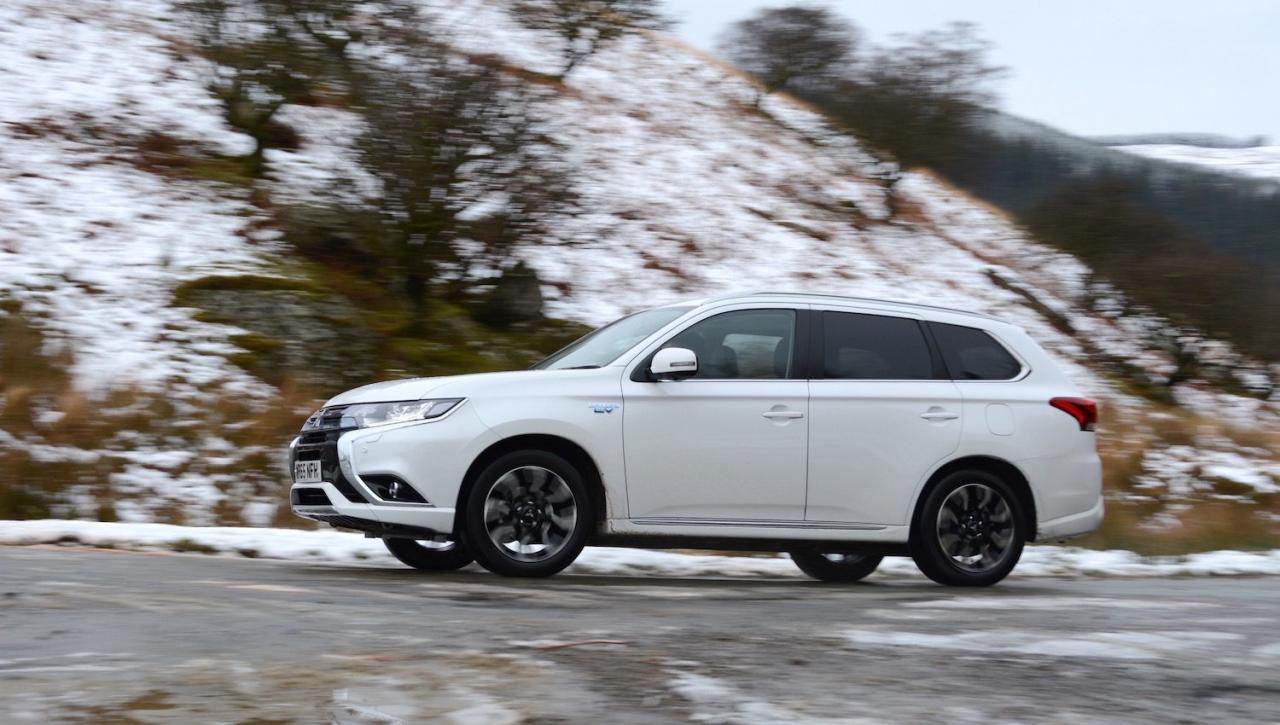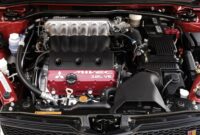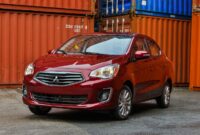Mitsubishi Outlander PHEV long term reliability reviews – Mitsubishi Outlander PHEV long-term reliability reviews: Thinking about a plug-in hybrid electric vehicle (PHEV)? The Mitsubishi Outlander PHEV is a popular choice, but how does it hold up over time? This deep dive explores real-world owner experiences, common problems, maintenance costs, and comparisons to competitors, giving you the lowdown on its long-term reliability. We’ll uncover the truth behind its reputation, separating fact from fiction to help you make an informed decision.
From reported mechanical issues and hybrid system quirks to the impact of driving habits and climate, we leave no stone unturned. We’ll analyze owner feedback, delve into repair costs, and examine warranty coverage. Whether you’re a prospective buyer or a current owner, this comprehensive guide will provide valuable insights into the Outlander PHEV’s long-term performance and help you navigate potential challenges.
Introduction to Mitsubishi Outlander PHEV
The Mitsubishi Outlander PHEV, a plug-in hybrid electric vehicle (PHEV), represents a significant entry in the crossover SUV market, blending practicality with environmental consciousness. It targets environmentally aware consumers seeking a spacious, family-friendly vehicle with the benefit of reduced running costs and lower emissions, without completely sacrificing the range and convenience associated with a gasoline engine. The Outlander PHEV isn’t just about eco-friendly driving; it also aims to offer a comfortable and versatile experience for daily commutes and longer journeys.The Outlander PHEV’s history traces back to the original Outlander platform, evolving through several generations.
Early models focused on establishing the PHEV technology, gradually improving battery capacity, electric motor power, and overall efficiency. Subsequent iterations refined the design, incorporating updated infotainment systems, advanced safety features, and more refined driving dynamics. The current generation represents a significant leap forward, boasting a more powerful electric motor, increased all-electric range, and a more sophisticated hybrid system.
Outlander PHEV’s Key Features and Target Market
The Outlander PHEV’s key features include its all-wheel-drive system, which utilizes electric motors to power the rear wheels, enhancing traction and stability, especially in challenging conditions. Its plug-in hybrid powertrain allows for extended periods of all-electric driving, reducing reliance on the gasoline engine and minimizing emissions. The spacious interior comfortably accommodates five passengers and offers ample cargo space.
Advanced driver-assistance systems (ADAS) contribute to safety and ease of driving. The target market encompasses environmentally conscious families, individuals seeking fuel efficiency, and those desiring the versatility of an all-wheel-drive SUV without the drawbacks of solely relying on gasoline power. Its combination of practicality, efficiency, and technology makes it appealing to a broad range of consumers.
Mitsubishi Outlander PHEV long-term reliability reviews often highlight its robust hybrid system. But beyond the mechanics, comfort is key, and you’ll find that enhanced with features like heated seats; check out how to Stay Cozy With Mitsubishi’s heated seats for extra winter warmth. Returning to the PHEV, these reviews consistently praise its overall durability, making it a solid long-term investment.
Public Perception of Outlander PHEV Reliability
General public perception of the Outlander PHEV’s reliability is largely positive, though not without some caveats. Many owners praise its fuel efficiency and the convenience of electric driving, highlighting the overall performance and functionality. However, some reports mention potential issues with the battery’s long-term durability and the complexity of the hybrid system, which can lead to higher repair costs compared to conventional vehicles.
Online forums and owner reviews reveal a mix of positive and negative experiences, indicating that while generally reliable, some potential problems should be considered. Independent reliability surveys often place the Outlander PHEV in the middle of the pack, suggesting that it is not exceptionally prone to failures but isn’t necessarily a top performer in this area either. The long-term reliability, however, is still subject to further evaluation as the current generation is relatively new.
Common Reported Issues and Problems
The Mitsubishi Outlander PHEV, while lauded for its innovative hybrid technology and spacious interior, isn’t immune to the occasional mechanical gremlin. Long-term owner reviews reveal a pattern of recurring issues, some minor annoyances, others more significant concerns impacting reliability. Understanding these common problems can help prospective buyers make informed decisions and prepare for potential maintenance needs. This section details the most frequently reported issues across various owner forums and independent reviews.
Mechanical Problems
Several mechanical problems have surfaced consistently in long-term Outlander PHEV reviews. These issues, while not universally experienced, highlight areas where owners have reported needing repairs or maintenance beyond standard servicing. The frequency and severity of these problems vary depending on driving habits, environmental conditions, and the specific model year.
Hybrid System Issues
The Outlander PHEV’s complex hybrid system, while generally reliable, presents unique challenges. Recurring problems related to the battery, motor, and associated components are a concern for some owners. Understanding these potential issues is crucial for managing expectations and budgeting for potential repairs. While many owners report trouble-free operation of the hybrid system, others have encountered issues that require professional attention.
| Problem | Frequency | Severity | Potential Solutions |
|---|---|---|---|
| Battery degradation (reduced range) | Moderate | Medium | Regular battery health checks, optimizing charging habits, potentially battery replacement under warranty. |
| Motor noise/vibration | Low | Low | Software updates (in some cases), inspection for loose components. |
| Hybrid system malfunction (warning lights) | Low | High | Immediate professional diagnosis and repair, often requiring specialized tools and expertise. |
| Brake system issues (regenerative braking related) | Low to Moderate | Medium | Software updates, brake system inspection and potential component replacement. |
Electrical and Software Glitches
Beyond mechanical issues, owners have reported a range of electrical and software glitches. These problems can manifest in various ways, from minor annoyances like malfunctioning infotainment systems to more serious issues impacting safety features. The frequency and severity of these glitches can vary significantly depending on the model year and software version.
Maintenance and Repair Costs: Mitsubishi Outlander PHEV Long Term Reliability Reviews
Owning a plug-in hybrid like the Mitsubishi Outlander PHEV introduces a unique set of maintenance considerations, blending aspects of both gasoline and electric vehicle upkeep. Understanding the potential costs involved is crucial for prospective buyers and current owners alike. This section delves into the specifics of maintenance and repair expenses, comparing them to similar vehicles and highlighting common repair scenarios.The Outlander PHEV’s maintenance costs are a complex equation.
While some aspects mirror those of a conventional SUV, the inclusion of a battery and electric motor adds layers of complexity and potentially higher repair bills in certain circumstances. Direct comparison to similar vehicles like the Toyota RAV4 Hybrid or Ford Escape PHEV requires careful consideration of factors such as age, mileage, and individual driving habits.
Comparison to Similar Vehicles
Generally, the Outlander PHEV’s scheduled maintenance costs are comparable to those of similar-sized gasoline-powered SUVs in the initial years. Regular servicing, including oil changes, filter replacements, and tire rotations, fall within a similar price range. However, the inclusion of the hybrid system means additional checks on the battery and electric motor components, which might slightly increase the overall cost compared to purely gasoline-powered counterparts.
For example, a standard oil change might cost around $80-$120, similar to a comparable SUV, but a comprehensive hybrid system check-up could add an extra $100-$150 depending on the service center and required diagnostics.
Cost of Replacing Common Failing Parts
While the Outlander PHEV enjoys a generally good reputation for reliability, certain components are more prone to failure than others. The 12-volt battery, for instance, may require replacement more frequently than in traditional vehicles, costing between $100 and $ Replacing the high-voltage battery, however, is a significantly more expensive undertaking, potentially costing thousands of dollars, though this is typically covered under warranty for a substantial period.
Other potential costly repairs might involve the electric motor, the inverter, or the charging system. These repairs could range from several hundred to thousands of dollars depending on the specific issue and labor costs. Consider a real-life example: a faulty inverter requiring replacement might cost upwards of $2,000 including parts and labor.
Parts Availability and Cost
Mitsubishi parts availability generally aligns with other major automotive brands. Authorized dealers usually have a good stock of common parts, ensuring relatively quick repair times. However, specialized components related to the hybrid system might take longer to procure, potentially leading to increased downtime. The cost of parts varies significantly, with generic consumables like filters and fluids being relatively inexpensive, while specialized hybrid components can command significantly higher prices.
For instance, a simple air filter might cost around $20, while a specific hybrid system sensor could cost several hundred dollars.
Mitsubishi Outlander PHEV long-term reliability reviews often highlight its spaciousness, a key factor for many buyers. But before committing to this PHEV, you might want to consider passenger capacity; check out this guide on How Many People Can Fit In A Mitsubishi? to ensure it meets your needs. Ultimately, understanding passenger space helps inform your decision on the Outlander PHEV’s long-term practicality and value.
Typical Maintenance Schedule and Costs
| Maintenance Item | Mileage Interval | Estimated Cost (USD) |
|---|---|---|
| Oil Change & Filter | 5,000 – 7,500 miles | $80 – $120 |
| Tire Rotation & Balance | 5,000 – 7,500 miles | $50 – $80 |
| Air Filter Replacement | 15,000 – 20,000 miles | $20 – $40 |
| Hybrid System Check-up | 15,000 – 20,000 miles | $100 – $150 |
| Brake Pad Replacement (Front) | 30,000 – 40,000 miles (varies greatly with driving style) | $200 – $400 |
| 12V Battery Replacement | Varies (3-5 years) | $100 – $200 |
Note: These costs are estimates and can vary based on location, dealer, and specific vehicle condition. Always consult your owner’s manual for the recommended maintenance schedule.
Owner Experiences and Feedback

Understanding the long-term reliability of the Mitsubishi Outlander PHEV requires examining real-world owner experiences. These experiences, both positive and negative, paint a clearer picture than technical specifications alone. By categorizing these accounts, we can identify common trends and potential problem areas.
Positive Long-Term Ownership Experiences
Many Outlander PHEV owners report high satisfaction with their vehicles, particularly regarding fuel efficiency and the overall driving experience. The hybrid system is frequently praised for its seamless transition between electric and gasoline power, offering significant savings on fuel costs, especially for shorter commutes. The spacious interior and versatile cargo area are also consistently highlighted as major plus points.
- Significant fuel savings compared to gasoline-only SUVs.
- Smooth and quiet electric driving mode, particularly in city environments.
- Ample interior space and practicality for families.
- Reliable performance over several years for many owners.
Negative Long-Term Ownership Experiences
While many owners report positive experiences, some recurring issues have emerged over the Outlander PHEV’s lifespan. These problems, though not universal, are important to consider before purchasing. Proper maintenance can mitigate some issues, but others may require more significant intervention.
Electrical System Issues
Some owners have reported problems with the battery management system, resulting in reduced electric range or unexpected power loss. These issues can be complex and expensive to diagnose and repair, often requiring specialized tools and expertise. In some cases, this has involved the complete replacement of the battery pack.
- Reduced electric range over time, sometimes significantly.
- Intermittent power failures or glitches in the hybrid system.
- High repair costs associated with battery system diagnostics and replacement.
Transmission Problems
While generally reliable, some owners have reported issues with the CVT transmission, including rough shifting or premature wear. The complexity of the hybrid system can complicate diagnosing transmission problems, potentially leading to longer repair times and higher costs.
- Rough shifting or hesitation in the CVT transmission.
- Premature wear and tear on the transmission components.
- Difficulty in diagnosing transmission issues due to the hybrid system’s complexity.
Engine Problems
Although less frequently reported than electrical or transmission issues, some owners have experienced engine-related problems, including issues with the gasoline engine’s performance or reliability. These problems can range from minor inconveniences to major engine failures, potentially resulting in substantial repair costs.
- Reduced engine power or performance issues.
- Engine warning lights indicating potential problems.
- In rare cases, complete engine failure requiring costly repairs or replacement.
Comparison with Competitors

The Mitsubishi Outlander PHEV’s long-term reliability is a key factor for potential buyers, especially when compared to its competitors in the plug-in hybrid SUV market. Understanding how it stacks up against rivals like the Toyota RAV4 Prime, Ford Escape PHEV, and Hyundai Tucson Plug-in Hybrid Electric Vehicle is crucial for assessing its overall value proposition. This section delves into a comparative analysis of long-term reliability, highlighting strengths and weaknesses relative to these competing models.The Outlander PHEV, while praised for its generous electric range and all-wheel-drive capability, has faced some reliability concerns, primarily related to its complex hybrid system.
Direct comparison with competitors reveals varying strengths and weaknesses across different areas of vehicle operation. Some competitors might boast superior battery longevity, while others may show better performance in specific component durability.
Reliability of Powertrain Components
The Outlander PHEV’s powertrain, a complex interplay of gasoline engine, electric motors, and battery pack, has been a focus of reliability discussions. While some owners report smooth, trouble-free operation for extended periods, others have experienced issues with battery degradation, motor malfunctions, or transmission problems. In comparison, the Toyota RAV4 Prime, often cited for its robust hybrid system, tends to show fewer reported issues in these areas based on owner forums and independent reliability surveys.
The Ford Escape PHEV and Hyundai Tucson PHEV present a mixed bag, with some model years exhibiting more reported powertrain problems than others. These differences are often attributed to variations in component design, manufacturing processes, and software updates implemented over the vehicle’s lifespan. For instance, early model years of the Escape PHEV saw more reported issues with the battery management system compared to later models.
Long-Term Battery Performance
Battery longevity is a critical aspect of PHEV ownership. The Outlander PHEV’s battery capacity and degradation rate have been subject to scrutiny. While the official warranty covers a significant portion of the battery’s lifespan, anecdotal evidence suggests varying degrees of capacity loss over time. Competitors like the RAV4 Prime have often been cited as exhibiting slower degradation rates, potentially translating to longer usable electric range over the vehicle’s lifespan.
However, real-world degradation is affected by factors like charging habits, climate, and driving style, making direct comparisons challenging. For example, consistently fast charging can accelerate battery degradation across all PHEV models, regardless of manufacturer.
Impact of Driving Habits and Climate
Driving style and climate significantly influence the Outlander PHEV’s long-term reliability. Aggressive driving, frequent rapid acceleration and braking, and consistent high-speed driving put extra strain on various components, potentially leading to premature wear and tear. Conversely, gentler driving habits extend the lifespan of the vehicle’s parts. Climate extremes also play a crucial role, impacting battery performance, engine efficiency, and the durability of various materials.Understanding how these factors interact is key to maximizing the Outlander PHEV’s longevity.
Proper maintenance practices can effectively mitigate the negative effects of both driving habits and extreme climates.
Driving Style’s Influence on Reliability, Mitsubishi Outlander PHEV long term reliability reviews
Aggressive driving styles, characterized by rapid acceleration and hard braking, increase the wear and tear on the brake pads, rotors, and tires. This leads to more frequent replacements, increasing maintenance costs. Furthermore, the constant stress on the engine and transmission can shorten their lifespan. Conversely, a smooth and gentle driving style, focusing on gradual acceleration and deceleration, minimizes stress on these components, leading to extended service intervals and reduced repair costs.
For example, a driver who consistently accelerates aggressively might experience brake pad wear twice as fast as someone who drives more smoothly.
Climate’s Impact on Vehicle Components
Extreme heat can degrade battery performance, reducing its range and lifespan. High temperatures can also affect the engine’s cooling system, potentially leading to overheating issues. Extreme cold, on the other hand, can impact battery charging efficiency and cause issues with the vehicle’s electrical systems. For instance, in extremely hot climates, the Outlander PHEV’s battery might experience a noticeable reduction in range compared to its performance in moderate temperatures.
Similarly, in sub-zero conditions, the battery might take longer to charge and may exhibit reduced performance.
Maintenance to Mitigate Impact
Regular maintenance is crucial for mitigating the effects of both driving habits and climate. This includes regular inspections of brake pads, rotors, and tires, along with timely replacements as needed. Scheduled maintenance should also include checks of the cooling system and battery health. In extreme climates, consider using specialized lubricants and fluids designed to withstand high or low temperatures.
For example, a regular check of the coolant levels and a thorough inspection of the cooling system components, particularly in hot climates, can prevent costly engine damage due to overheating. Similarly, in cold climates, using a battery maintainer can help preserve battery health and prevent issues caused by low temperatures.
Warranty and Service Coverage
Understanding the warranty and service coverage for your Mitsubishi Outlander PHEV is crucial for long-term ownership. This section details the manufacturer’s warranty, its typical coverage, and the options available for extended warranties, helping you make informed decisions about protecting your investment.The Mitsubishi Outlander PHEV typically comes with a comprehensive manufacturer’s warranty. Specific terms and conditions can vary slightly depending on the year of manufacture and your location, so always refer to your owner’s manual or contact your local Mitsubishi dealership for precise details.
However, generally, the warranty covers defects in materials and workmanship for a specified period.
Manufacturer’s Warranty Coverage
The standard Mitsubishi manufacturer’s warranty usually includes coverage for a certain number of years or miles on the vehicle’s major components, such as the engine, transmission, and drivetrain. Additionally, the warranty typically extends to certain emission control components and may also cover some electrical components. The battery pack, a key component of the PHEV system, often receives specific warranty coverage that extends beyond the standard powertrain warranty, though the specifics vary depending on the model year.
For example, the battery might be covered for a certain number of years or a certain percentage of capacity degradation. It’s important to note that the warranty typically doesn’t cover wear-and-tear items like tires, brakes, or routine maintenance.
Extended Warranty Options
Mitsubishi, along with third-party providers, often offers extended warranties for the Outlander PHEV. These warranties provide additional coverage beyond the manufacturer’s warranty, potentially covering repairs for a longer period or a higher mileage limit. Extended warranties can offer peace of mind, especially for owners who plan to keep their vehicle for an extended period. However, it’s important to carefully review the terms and conditions of any extended warranty before purchasing, paying close attention to what is and isn’t covered, and any associated deductibles.
The cost of an extended warranty varies depending on the length of coverage, the level of coverage, and the age and mileage of the vehicle. For example, a longer warranty with broader coverage will generally be more expensive than a shorter, more limited warranty. Consider the potential repair costs versus the cost of the extended warranty to determine if it’s a worthwhile investment for your individual circumstances.
Illustrative Examples of Repair Scenarios
Understanding the potential repair costs associated with the Mitsubishi Outlander PHEV is crucial for prospective buyers. While generally reliable, like any vehicle, it can experience issues ranging from minor inconveniences to significant repairs. The following scenarios illustrate the spectrum of repair experiences owners might encounter.
Major Repair: High-Voltage Battery Replacement
Imagine this: After five years of ownership and approximately 70,000 miles, your Outlander PHEV’s high-voltage battery begins to show signs of degradation. The range significantly decreases, and the car struggles to maintain sufficient charge. A diagnostic test confirms the battery needs replacing. This is a substantial repair. The cost, including parts and labor, could easily exceed $5,000, depending on the specific battery model and your location.
The repair might take several days, as the battery is a complex component requiring specialized tools and expertise. While some warranties may cover battery issues for a certain period or mileage, going beyond that warranty necessitates a significant financial outlay. This scenario highlights the importance of understanding the battery’s warranty terms and considering extended warranties as a form of financial protection.
Minor Repair: Replacement of a Faulty Parking Sensor
A less severe, yet still common, issue involves the parking sensors. Let’s say one of the sensors malfunctions, resulting in intermittent or inaccurate readings. This is a much less costly repair. The replacement part might cost between $100 and $200, and the labor to install it should be relatively inexpensive, potentially costing another $100-$200, depending on your mechanic’s rates.
The repair time is likely to be a couple of hours at most. This example shows that some repairs can be relatively straightforward and affordable.
Impact of Preventative Maintenance
Regular preventative maintenance significantly reduces the likelihood of expensive repairs like the high-voltage battery replacement. Sticking to the manufacturer’s recommended service schedule, including timely inspections and fluid changes, helps identify potential problems early on. For example, early detection of a failing battery cell through regular diagnostics might allow for proactive intervention, potentially delaying or even preventing the need for a complete battery replacement.
This proactive approach can save thousands of dollars in the long run, emphasizing the importance of regular servicing for long-term cost savings and vehicle longevity.


